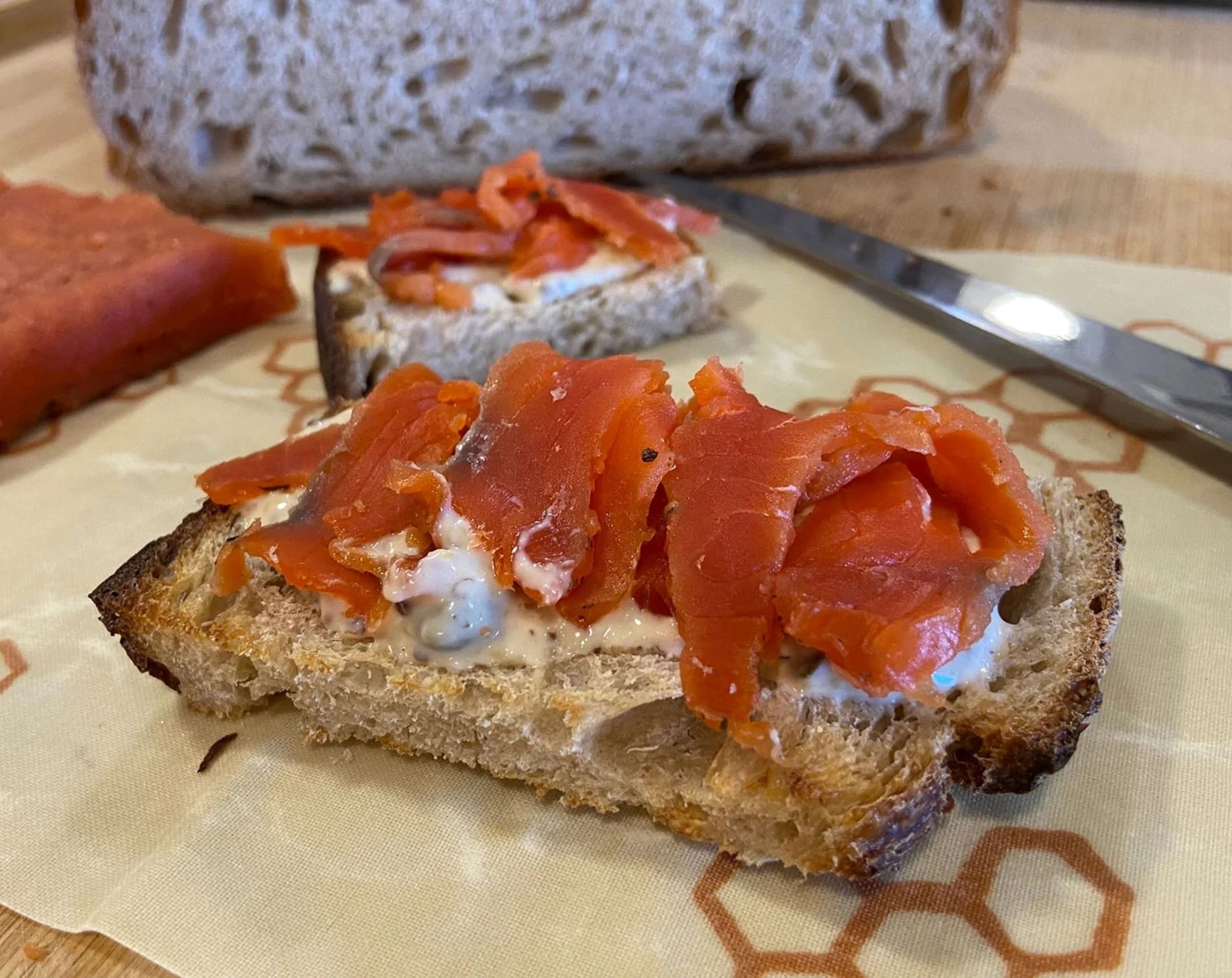Gravadlax, Gravlax, Lax, Lox, This is an ancient Nordic dish that translates to “buried salmon.” All you need is salt, sugar, and time. If you’ve ever had bagels and lox then you’ll love this at home technique. The curing process results in a fatty dense texture of your sablefish/salmon and the natural flavor of the fish will be brightened by the sugar, salt, clove, lemon, and pepper. Mastering this technique will elevate your street cred’ and give you a reason to buy more bagels.
Recipe
Prep time: 15 min
Total time: 72 hr
Serves: 2-4
INGREDIENTS
Special Equipment:
- Mortar and pestle or spice grinder
- A sharp flexible knife (a fillet knife will work)
Gravlax:
- 1 tablespoon grated lemon zes
- 1 teaspoon whole coriander seeds or fennel seeds
- 1 teaspoon whole black peppercorns
- 4 whole cloves
- ½ teaspoon whole mustard seeds
- 1 ½ tablespoons kosher salt
- 5 ½ teaspoons sugar
- ½ pound thawed salmon with skin (coho, sockeye, or king salmon), pin bones removed
- 2 sprigs roughly chopped fresh dill
Mustard Dip:
- 2 teaspoons brown sugar
- 2 teaspoons whole grain mustard
- 1 teaspoon white wine vinegar
- 2 teaspoons chopped capers
- ¼ cup creme fraiche or sour cream
- 2 teaspoons finely chopped fresh dill (optional)
DIRECTIONS
Gravlax:
In a mortar or spice grinder, combine lemon zest, coriander, peppercorns, cloves, and mustard seeds and grind very coarsely. Do not overgrind. Transfer to a small bowl and stir in the salt and sugar.
In a glass or ceramic dish, evenly sprinkle ¼ of the spice mixture. Add the fish, skin-side down and sprinkle the top of the fish with the remaining mixture. If using a fillet from the tail, apply less mixture toward the end. Gently pat the mixture onto the salmon so it sticks. Place dill on top of the fish. Cover tightly and refrigerate for 12 hours.
After 12 hours, the spice mixture will draw out moisture from the salmon which will accumulate in the bottom of the dish. Drain this liquid and refrigerate for another 12 hours. After 24 hours, slice a small piece from the thickest part of the fish and taste. The entire portion should be firm like a well-done steak. The taste should be a nice balance of sweet and salty. If a stronger flavor is desired, cover salmon and return to the refrigerator for another 12 to 24 hours or up to 6 days, draining as often as needed.
Once the desired flavor is achieved, rinse the cured fish well under cold water and pat dry. Place cured fish in an open dish and refrigerate for 5 hours to develop a glossy surface, create a nice texture, and increase the shelf life.
Slicing:
The goal is to make a slice thin enough you can “read the New York Times through it,” This will take a lot of practice. Traditionally a large side of salmon is cured, which makes slicing a bit easier.
Place the gravlax on a cutting board at the edge of the counter. Start your first slice ¼ centimeter back from the thickest end of the portion. Use long deliberate strokes straight down. When you reach the skin, slightly angle the knife up and finish the cut. You can remove any grayish areas of the meat if you like. If the blade seems tacky, wet the blade. Continue slicing by placing the blade ¼ centimeter behind the first cut. Repeat the slicing process, wetting the blade as needed.
Serve with mustard dip or cream cheese on a thick cracker, bagel, or sliced bread, preferably sourdough or baguette.
Mustard dip:
In a small bowl, combine brown sugar, mustard, white wine vinegar, chopped capers, and creme fraiche or sour cream and whisk until smooth. Season with salt to taste. Add chopped fresh dill, if using, and mix together.
TIPS
The most important part of this process is the salt-to-sugar ratio. If this is your first time making gravlax, use a 1:1 ratio of salt to sugar. This measurement should equal a combined weight that is 25% of the total weight of the fish you are curing. So for ½-pound (225 grams) of fish you will use about 5 ½ teaspoons (30 grams) of sugar and 4 ½ teaspoons (30 grams) of salt.
Removing the pin bones prior to curing is important because the curing process makes bone removal difficult as the meat firms up.
Tail pieces of salmon tend to work best for gravlax because they are easier to slice. Draining the dish is optional, but it does help to control the saltiness.
You can choose to leave skin on or remove it before curing. If you choose to remove the skin you should also trim any gray insulating fat from the bottom of the fish.
Use less spice mixture near the end of thinner tail pieces so as not to over cure the fish.
A little brandy or vodka is very traditional for curing gravlax. If available, brush the salmon with 1 ounce per pound and let sit for 5 minutes, then apply the spice mixture.
When curing small portions (½ to 1 pound), it's best not to place weight on top of the fish. The flesh becomes too dense. Weighing down the salmon is traditional with larger whole salmon sides.
Salmon gravlax is best after 24 to 36 hours.
24 hours = light cure. A great place to start.
48 hours = medium cure
72 hours or more = long cure
Once cured for at least 24 hours, gravlax should last up to a week in your refrigerator. It also freezes nicely.


